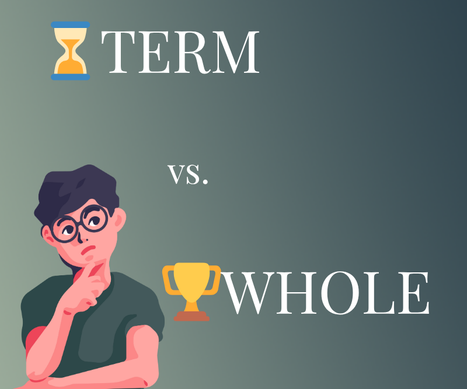Term vs Whole Life: Key Differences Explained
Understanding life insurance can feel overwhelming, especially when deciding between term and whole life policies. So what is the difference between term and whole life insurance? Is term or whole life better? Both provide valuable protection, but the best choice depends on your unique financial goals, family priorities, and current stage of life. By understanding the key differences, you can make an informed decision that aligns with your long-term aspirations.
We’re here to simplify the process. Our clear and straightforward guide will help you confidently select the policy that best fits your needs today and secures your future tomorrow.

⏳ What Is Term Coverage?
Term life insurance provides coverage for a specific period—commonly in 10 or 20 year terms. If something happens to you during that time, your beneficiary is guaranteed to receive the death benefit, which can help protect their financial future or pay off obligations like a mortgage, debts, or education costs.
✅ Term Life Pros and Cons
Pros of Term Life Coverage:
-
Affordable premiums: Term policies usually have lower monthly payments, making them budget-friendly, especially for younger adults.
-
Simple, straightforward coverage: Designed to protect against specific financial risks for a set period.
-
Ideal for temporary needs: Perfect for young families, new homeowners, or anyone with financial obligations that will eventually end (like raising kids or paying off debt).
-
Convertible options: Some term policies allow conversion to permanent life insurance later, providing flexibility as your needs change.
Cons of Term Life Coverage:
-
No payout if you outlive the term: If you survive the coverage period, the policy ends with no return of premiums paid.
-
No cash value: Term life serves purely as protection and does not build savings or investment value.
-
Renewal costs: Extending coverage after the term can mean higher premiums due to age or health changes.
Think of term life insurance like renting coverage—you get protection when you need it most, but it doesn’t accumulate cash value or become a financial asset over time.

🏆 What Is Whole Coverage?
Whole life insurance is a type of permanent life insurance designed to provide lifetime coverage—as long as premiums are paid. In addition to the guaranteed death benefit, whole life policies build cash value over time, which you can borrow against, withdraw, or use later to support your financial goals.
✅ Whole Coverage Pros and Cons
Pros of Whole Coverage:
-
Guaranteed lifelong protection: Your loved ones are covered no matter when you pass, providing long-term peace of mind.
-
Builds cash value: Over time, your policy grows savings you can use for emergencies, tuition, or to supplement retirement.
-
Fixed premiums for life: Your monthly rate stays consistent, making it easier to plan long-term.
-
Long-term financial asset: Acts as part of a larger wealth-building strategy—not just protection.
Cons of Whole Coverage:
-
Higher premiums: Whole life costs more than term, making it a bigger financial commitment upfront.
-
Slow to build cash value: It may take several years before you see meaningful growth in the policy’s value.
-
May not be necessary for short-term needs: If you only need coverage for a set time (e.g., mortgage or dependent care), term might be more practical.
Think of whole life insurance like owning a home—you’re building equity over time while maintaining lifelong coverage and creating a financial asset your family can rely on.
🔍 Term vs. Whole: A Side-by-Side Comparison
Feature
Coverage Length:
Cost:
Cash Value:
Fixed Premiums:
Best for:
Term Life
10-20 years typically
Lower Premiums
❌ No
✅ Yes (for term duration)
Temporary needs, budget
Whole Life
Lifetime
Higher Premiums
✅ Yes (for life)
✅ (for life)
Long term planning, wealth building
Which Type of Life Insurance Is Right for Your Family?
Ask yourself these important questions:
-
Do we need coverage for a specific time period—like until the kids are grown or the mortgage is paid off?
→ Term life might be the most practical and budget-friendly choice. -
Do we want lifelong protection plus a way to build savings over time?
→ Whole life could be the better fit for your goals. -
Can we manage higher monthly premiums in exchange for permanent coverage?
→ If so, whole life may offer the stability and value you're looking for. -
Do we need affordable, simple coverage that works now?
→ Start with term life, and consider converting it to whole life later if your needs evolve.
✨ Final Thought
There’s no one-size-fits-all answer when it comes to life insurance. The right policy depends on your family’s unique stage of life, financial priorities, and future goals.
Whether you choose term, whole, or a blend of both, the most important thing is taking that first step toward protection. Life insurance provides priceless peace of mind—knowing your loved ones will be financially supported, no matter what the future holds.
🔮Let’s Face It—The Future Has a Way of Showing Up
...kind of like that one relative who never RSVPs, yet still arrives with a plus-one and a questionable casserole.
That’s why it pays to plan ahead. Taking action today means your future self—and your family—will be grateful you did.
Adulting’s a Struggle. Life Insurance Doesn’t Have to Be
Let’s walk through your options together. I am here for you.
📝 Get a No-Obligation Consultation
Includes your Personalized Needs Analysis, Will Kit, and Custom Life Insurance Quote—all at no cost.

